Our galaxy is similar.
Here is a photo of part of the Milky Way, in the direction of the center
of our galaxy. Here again you can see lots of dust (the dark parts,
where the dust is covering up the stars), and gas (generally brighter parts,
where the light from stars is reflected).
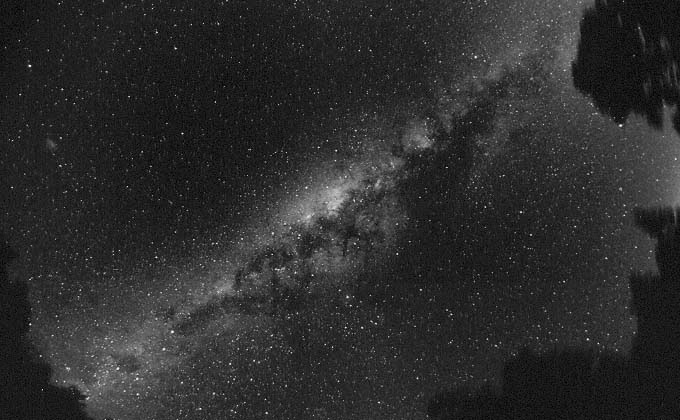
When we look at one of these
clouds up close, we see lots of structure, as in this photo of the gas
and dust pillars in the Eagle Nebula.
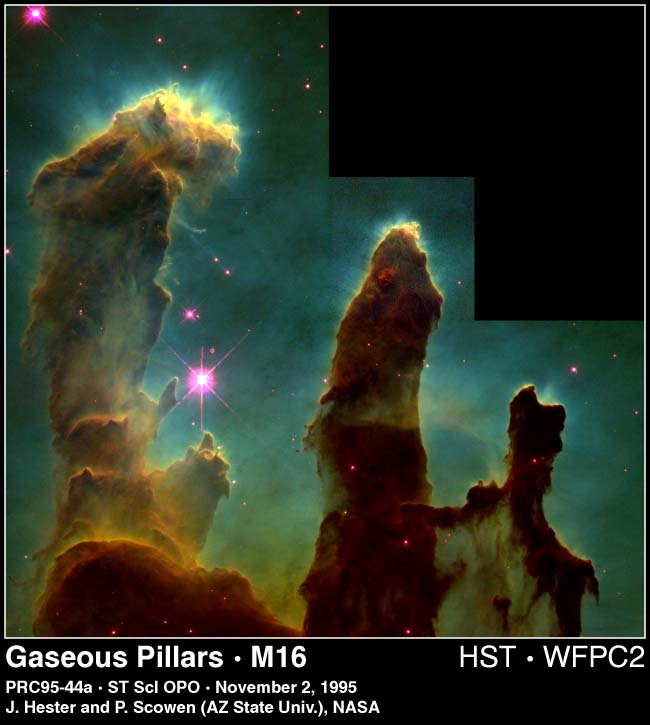
So where did it all come
from? Some of it is left over from the original creation of the Universe.
It is the hydrogen and helium gas from which the galaxy itself formed.
However, a lot of it comes from previous generations of stars. When
stars, especially the more massive ones, go through their lives and die,
they return most of their mass to the Interstellar
Medium. This material, enriched in heavy elements like
carbon, oxygen, nitrogen, and heavy metals that we need to survive, goes
into the new generation of stars.
What Are the Clouds Like?
Space is full of hot (fast
moving) particles and high-energy radiation (photons) from stars that make
for a high temperature. In order for a cloud to collapse to form
a star, it has to be very dense and it has to be very cold, typically only
10-30 K. The dust in the clouds is very important in keeping the
cloud cold, by shielding the inside of the cloud from the radiation, and
by reradiating internal heat in the infra-red. Inside the clouds,
the gas cools down and starts to combine into molecules, like H2,
CO, CO2, H2O,
and many even larger molecules. For this reason, these are called
molecular
clouds.
What Causes the Collapse?
In the densest part of the
clouds, it is also the coldest, and these two things combine to allow gravity
to take hold and start the collapse. You can imagine that the mass
of the star that results from a local collapse is random, and depends only
on the mass of the initial part of the cloud, by chance. Most stars
end up being of order 1 solar mass, and the more massive stars are rare.
The gas is swirling around, and any random rotational motion is highly
magnified during the collapse due to conservation of angular momentum.
From Cloud to Protostar
As the initial collapse
begins, the particles of gas and dust begin to fall toward the concentration
of mass in the center. This is the same gravitational
contraction that we discussed earlier, and it converts potential
energy into kinetic energy, i.e. heat. But the initial collapse is
slow enough that the heat can be radiated away in the infra-red, keeping
the cloud cool. During this time, the temperature remains below 100
K, and the cloud glows in long wavelength IR.
Eventually, the central parts
become so dense that they become opaque to IR, and the heat can no longer
escape. At this point, the internal pressure and temperature rise
dramatically, and the central object becomes what is known as a protostar,
the seed from which a star will grow. During this time, a protostellar
disk forms due to conservation of angular momentum. Magnetic
fields generated inside the central, rapidly spinning object sweep through
the disk, transferring momentum from the protostar to the disk. The
magnetic fields also generate a protostellar wind that is directed mostly
out from the poles of the protostar, creating polar
jets. Here is a photo of a protostar called HH30, which
clearly shows the dark disk and the polar jets. The HH stands for
Herbig-Haro objects, named after their discoverers.
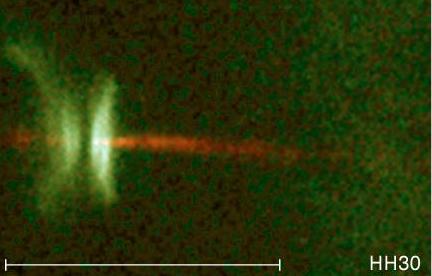 Of course, planets can form
from the dense protostellar disk, as we have learned earlier. Eventually,
the strong protostar winds will sweep away all of the gas of the disk,
and leave the planetesimals behind to coalesce into a few larger bodies
of planets.
Of course, planets can form
from the dense protostellar disk, as we have learned earlier. Eventually,
the strong protostar winds will sweep away all of the gas of the disk,
and leave the planetesimals behind to coalesce into a few larger bodies
of planets.
A Star Is Born
Eventually, the internal
pressure and temperature grow high enough (more than 10 million K) to start
fusing hydrogen (protons) into helium. At the onset of nuclear fusion,
the object officially becomes a star. Once fusion gets going and
the star adjusts to its new equilibrium, the gravitational collapse halts
and the star becomes a Main Sequence star.
Where it falls on the Main Sequence is entirely dependent only on the initial
mass of the star. All stars of the same mass will have the same surface
temperature, and the same size, and so will have the same luminosity and
will be in the same place on an H-R diagram.
Prior to arriving at the Main Sequence,
however, the protostar would have a different surface temperature and luminosity,
and so would be in a different place on the H-R diagram -- and this location
would change with time. It is interesting to plot the location of protostars
in the H-R diagram as they evolve (called an evolutionary
track). Each point merely represents its surface temperature
and luminosity at each some moment during its life as a protostar. The
next figure shows these evolutionary tracks for different mass stars.
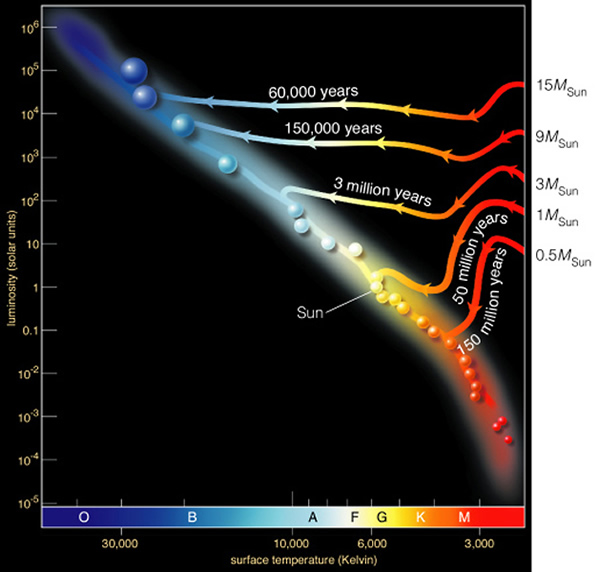
We can easily describe
the stages of life of a low-mass star. We will see that as a star
ages, its external characteristics -- size and surface temperature -- change.
Remember that what causes the changes is the star's fuel supply, coupled
with the interplay between the inward force of gravity and the outward
pressure. When the star first arrives on the Main Sequence,
it is burning hydrogen fuel into helium in its core. All stars on
the Main Sequence are doing this. This is the most efficient way
of producing enough energy to support the star, so the fuel burns relatively
slowly. Most of the lifetime of the star is spent on the Main Sequence.
In the case of the Sun, this is 10 billion years.
After 10 billion years, the
Sun begins to run out of hydrogen fuel in its core. All this time
it was converting hydrogen into helium, so near the end of this period
the core is entirely helium. The helium is inert, and in fact is
an interesting
state of matter called degenerate matter.
The pressure and density are so high that the pressure no longer depends
on temperature at all. When the core runs out of hydrogen, something
has to happen to keep the star from collapsing. What happens is that
the core shrinks into this degenerate state, and the hydrogen in higher
layers reaches a high-enough temperature to allow it to start fusion reactions.
This is called hydrogen shell burning, and it occurs at an even higher
rate than the core burning. Because of the higher rate of energy
production, the overall luminosity of the star increases. During
this stage, the star begins to expand, and becomes a Red Giant. The
star "turns off" of the Main Sequence and grows more luminous but at the
same time the surface temperature decreases. As hydrogen burns hotter
and hotter in the star, the surface continues to expand while the core
contracts.
After several hundred million
years in this process, the core to reaches such a high temperature, 100 million
K, that suddenly the helium ignition temperature is reached. The once
inert core suddenly (in a matter of minutes!) flashes into ignition and inflates
the core rapidly. Paradoxically, this inflation of the core causes the
outer layers to shrink, and the Red Giant actually grows smaller. The
moment of ignition is called the Helium Flash.
In helium fusion (called the triple-alpha process), three helium atoms combine
into a carbon atom. This occurs at a much higher temperature than hydrogen
fusion due to the fact that helium nuclei each have two + charges, whose repulsion
must be overcome by crashing them into each other at high speeds. The
shrinking star gets a hotter surface temperature, but a lower luminosity,
so it moves back toward the Main Sequence. It stays here, burning helium
in its core (and perhaps burning hydrogen in a shell at the same time), for
about another billion years.
Eventually, the helium in
the core is again going to all be used up, and the entire process happens
again. We can almost use the same words above, except replacing hydrogen
with helium, and helium with carbon. Eventually the core contains
only inert carbon, and a shell around the core starts burning helium.
In this helium shell burning stage, the core again shrinks and the outer
layers of the star expand due to the increase in rate of energy production
(luminosity). This time the star may become a Red Supergiant, but
its days are numbered. It already ran out of hydrogen fuel in the
previous Red Giant stage, and now it is running out of helium fuel.
For stars like the Sun, the core
never can reach the temperature (600 million K!) needed to fuse carbon into
heavier elements. Instead, during a process that is not at all understood,
the outer layers of the star are ejected into space in a planetary nebula.
Such planetary nebulae
are seen throughout the galaxy, and in other galaxies, in quite large numbers
considering that they only last for a few thousand years before they dissipate
and disappear into the interstellar medium.
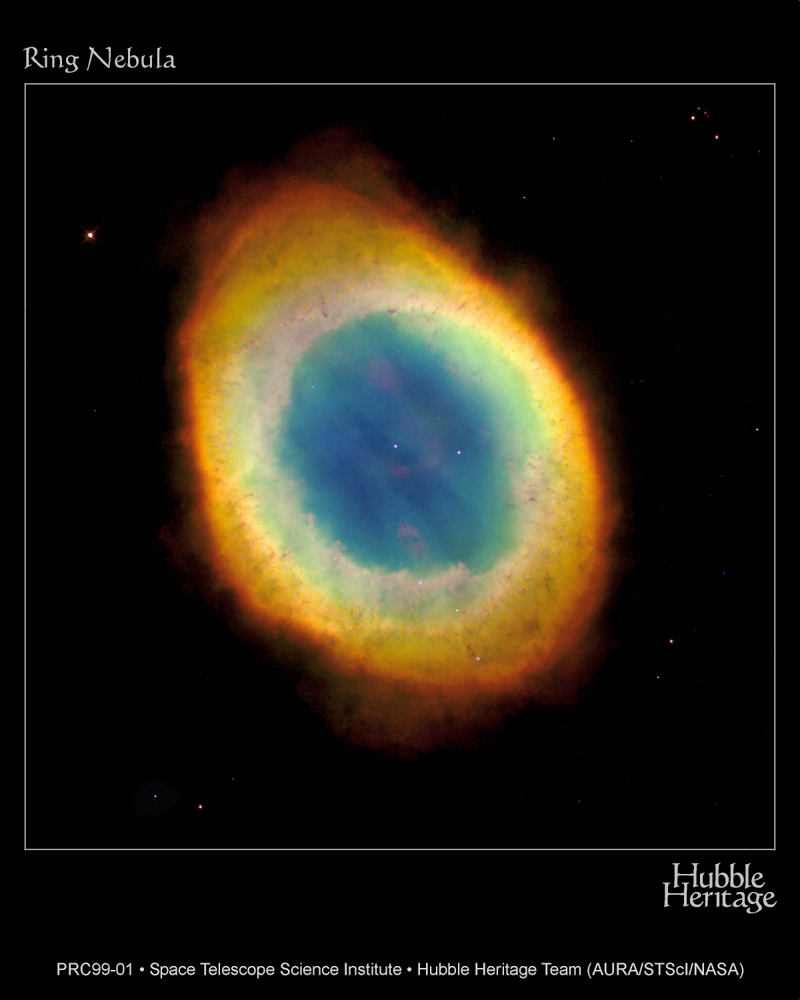
What is happening in the star
to cause this? The problem is that the helium shell burning phase is
very unstable. We said that the temperature has to be at least 100 million
degrees. But it is hard to regulate such a high temperature when the
amount of mass in the outer layers (the pressure cooker lid) is so small.
The temperature gets a bit too high, and the star expands too much.
The temperature drops and the pressure goes down, so the outer layers shrink
again, but then they shrink too much, the temperature rises, and the whole
thing starts again. These are called thermal
pulses. The outer star layers oscillate, losing mass in each
oscillation until most of the outer layers are gone.
What is left, then, is just
the inert carbon core, which is VERY hot (100,000 K at first), and small
(only about the size of Earth), even though it has a mass of nearly one
solar mass. This is a White Dwarf star. It no longer generates
any energy (no fusion takes place any longer), so it slowly cools down
and follows the sloping line for constant radius in the H-R diagram that
we mentioned last time.
To see the process graphically,
let's work through Lesson 2 of the Stellar
Evolution Tutorial.





